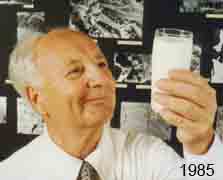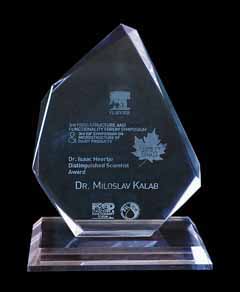|
Miloš Kaláb
1 Studies and work in Czechoslovakia 2 Scientific work in Canada 3 Practical applications of scientific studies 4 Journalistic activity 5 Notes 6 References 7 External links 1 Studies and work in Czechoslovakia After graduating in 1948 from the Polívka (now Slavonic) High School in Olomouc, Kaláb studied chemical engineering at the Technical University in Brno until its conversion into the Military Technical Academy in 1951. In the years 1950-1951 he practised as a chemist in a sugar factory. He completed his civilian studies at the Slovak University of Chemical Technology in Bratislava in 1952 and graduated as a chemical engineer. In the years 1953-1957, he studied pectic substances in wild apples as a postgraduate student at the Slovak Academy of Sciences. In 1957, he graduated as a Candidate of Chemical Sciences (CSc.). Because of a housing crisis in Bratislava, he left two years later for the Medical Faculty at the Palacký University in Olomouc. In 1962, he obtained the degree of Associate Professor ("Docent") for his study of arginase biochemistry. In 1966, he was appointed head of the Department of Organic Chemistry and Biochemistry at the Faculty of Science. Since 1960, he prepared, in his free time as a volunteer of the Chemical Abstracts Service (CAS), more than 16,000 abstracts in English of scientific papers on biochemistry, medicine, and agriculture published in Czech, Russian, and Slovak languages. 2 Scientific work in Canada In September 1966, he joined the biochemical laboratory of W. H. Cook at the National Research Council of Canada in Ottawa as a postdoctorate fellow. There, he studied lipoproteins in pig and human blood serums. The scheduled return to Olomouc in late August 1968 was cancelled because of the invasion of Czechoslovakia. In the summer of 1968, he was interested in the differences between the Czechoslovak and Canadian cottage cheeses. His interest brought him to the laboratory of D. B. Emmons at the Food Research Institute of the Canadian Federal Department of Agriculture. A few weeks later, this contact ensured him a new employment. He had been assigned an objective to develop imitation frankfurters from skim milk powder [1], of which there had been a surplus in Canada. To better understand the microstructure of both products, Kaláb started to learn electron microscopy in the laboratory of G. H. Haggis. It showed that it is impossible to imitate meat products, which are composed of muscle fibers, using milk, which consists of submicroscopic protein globules (casein micelles). A new director of the Institute, John Holme, cancelled the objective and gave Kaláb the freedom to do research according to his own considerations. This lasted for nine years, until the director left the Institute. Kaláb specialized in dairy products. He also used to introduce electron microscopy methods used in medicine and biology into the studies of food microstructure. With three American colleagues, S.H. Cohen, E.A. Davis and D.N. Holcomb, Kaláb organized annual international conferences under the auspices of Scanning Electron Microscopy International, Inc., directed in Chicago by Om Johari, an American scientist of Indian origin. In 1982, the group established a scientific journal, Food Microstructure [2], later renamed Food Structure [3], of which he became the editor-in-chief. Throughout the existence of the journal, all issues were regularly sent free of charge to the Centre of Scientific and Technical Informations of the Food Industry in Prague. In 1982, Kaláb was awarded the Pfizer Award from the American Dairy Science Association. In 1986, he worked shortly as a United Nations Organization FAO consultant at the Indian National Dairy Research Institute in Karnal in the state Haryana. In 1989, he received a grant from the Government of Japan to lecture on the structure of dairy products in Tsukuba, Tokyo, and Sapporo. In 1991, he was a visiting researcher at the State University of Utah in Logan. About three years later he retired as a principal research scientist at the Department of Agriculture and immediately accepted a contract for a reduced working duty at the Food Research Centre in Guelph. The contract used to be renewed annually until 2004. He has been working for free in electron microscopy of foods, bacteria, and blood cells as an Honorary Research Associate at the Department of Agriculture. In addition to working in agricultural research, he collaborates with the Canadian Blood Services. On June 3, 2018, the Food Structure and Functionality Forum conferred the Dr. Isaac Heertje Distinguished Scientist Award on M. Kaláb. 3 Practical applications of scientific studies
Canadian Food Inspection Agency laws did not allow dried buttermilk to be used as an ingredient in meat binders because it is susceptible to imparting rancid off-flavour. Other milk solids were acceptable. There was, however, no method that would detect buttermilk if the law had been violated until transmission electron microscopy was used. The detection of buttermilk is based on the presence of fat globule membrane fragments produced during the churning of cream. — The procedure used to manufacture Cheddar cheese (cheddaring) produces produces characteristic "milled curd junction patterns" which may be visualized in cheese slabs. Along with collaborators R. J. Lowrie and D. Nichols, Kaláb suggested to use the patterns [4] in order to protect consumers when establishing what kind of cheese they are buying. M. Kaláb and V. R. Harwalkar discovered a characteristic microstructure of casein micelles developing during acid coagulation of milk at pH 5.5. They called it the core-and-shell structure. It is present in the Indian Paneer cheese [5] and the Spanish Queso Blanco cheese [Ed. 1]. The structure is not destroyed by cheese processing. — Using electron microscopy, Kaláb and J. Yun detected recycled cheese (rework) in processed cheese [6]. It is manifested by the incidence of microscopic areas of compact protein. In order to increase the graphic value of black and white electron micrographs, Kaláb colourized them digitally. He was invited by The Royal Microscopical Society [Ed. 2] in the UK to publish his papers thus illustrated. He summed up his most important studies of milk in the paper "The Beauty of Milk at High Magnification" [7], In a similar way, he reviewed the results of his study of microorganisms in "Microscopy and Hygiene" [8] and "Conventional Scanning Electron Microscopy of Bacteria" [9]. He has authored over 170 scientific papers and book chapters. Many of them may be downloaded from his profile in ResearchGate [10], where there is a free access to the majority of the review papers, e.g., [11] [12] [13] [14] which Kaláb has published, including the freely accessible papers in the digital form of Food Microstructure and Food Structure [15], such as the "Practical aspects of electron microscopy in dairy research" [16]. D.N. Holcomb and Kaláb were the editors of the book Studies of Food Microstructure [17]. 4 Journalistic activity Kaláb's journalistic career began immediately after World War II while he was still a student. He published a Boy Scouts Tam-Tam monthly in the Olomouc 14th Section and directed a Boy Scouts Patrol column in the České slovo (Czech Word) newspapers. He had student penfriends in Scandinavian countries, Britain and India, and contributed information from their letters in the local newspaper. In addition, his articles criticized various political situations. In the years 1972-79, Kaláb published The Food People, a Food Research Institute monthly in Ottawa. The monthly number of issues published increased from 45 to 225. After 1989, he used to correct misconceptions about life in the West in the Canadian Letters by Miloš Kaláb [18] published in the Neviditelný pes (Invisible Dog) internet magazine. After the reorganization of the magazine, he contributed to Tramvaj Načerno (Street Car without Paying) by Zdeněk Fekar and after the termination of this magazine he has published more than 300 articles in Britské listy (British Letters) before he discontinued contributing in 2014. He has fulfilled his lifetime desire to work, at the same time, in chemistry, industrial visual arts (electron microscopy in colors, copper enameling [19]), and journalism. With wife Drahomira he has sons Pavel and Peter, engineers of information technology. 5 Notes Note 1 (English) for more information in the English Wikipedia on Queso Blanco. Note 2 (English) for more information in English on The Royal Microscopical Society. 6 References [1] Imitation frankfurters made from milk powder. [2] Food Microstructure - Food Structure. [3] Tables of Contents of Food Microstructure and Food Structure. [4] Milled curd granule junction patterns. [5] Development of microstructure in raw, fried, and cooked and fried Paneer made from buffalo, cow, and mixed milks. M. Kalab, S.K. Gupta, H.K. Desai, G.R. Patil. Food Microstructure 7 (1), 1988, 83-92. [6] Textural properties and microstructure of process cheese food rework. M. Kaláb, J. Yun, S. H. Yiu. Food Microstrucure 6(2) 1987, 181-192. [7] The Beauty of Milk at High Magnification. [8] Microscopy and Hygiene. [9] Conventional Scanning Electron Microscopy of Bacteria. [10] ResearchGate profile of Miloslav Kalab. [11] Processed cheese products. Marijana Carić, Miloslav Kalab. In: Cheese: Chemistry, Physics and Microbiology. Volume 2 Major Cheese Groups. pp. 339-383. P.F. Fox (Editor) Elsevier Applied Science, London and New York, 1987. ISBN 1-85166-053-4 (v. 2) [12] Electron microscopy of foods. Miloslav Kalab. In: Physical Properties of Foods. M. Peleg and E.B. Bagley (editors) AVI Publishing Company, Inc., Westport, CT, USA, 1983, pp. 43-104. ISBN 0-87055-418-2. [13] Food structure and milk products. Miloslav Kalab. In: Encyclopedia of Food Science and Technology. pp. 1170-1196. YH Hui (Editor), Wiley Interscience, 1991, 3016 pp. ISBN 0471505412, 9,780,471,505,419th [14] Practical aspects of electron microscopy in cheese research. Miloslav Kaláb. In: Chemistry of Structure-Function Relationships in Cheese. pp. 247-276. E.L. Malin and M.H. Tunick (editors), Plenum Press, New York, 1995. ISBN 978-1461357827. [15] Studies of Food Microstructure (A book). [16] Food Microstructure and Food Structure in digital form. [17] Practical aspects of electron microscopy in dairy research. Miloslav Kaláb, Food Structure 12 (1), 1993, pp. 95-114. [18] Canadian Letters by Milo Kaláb. [19] Copper enamelling. 7 External links Foods under the microscope. The archive for Foods under the microscope. | |||
| Comments to the author, please. Thank you. |

